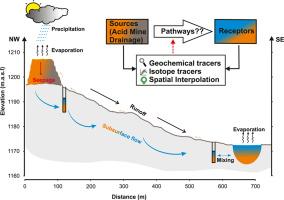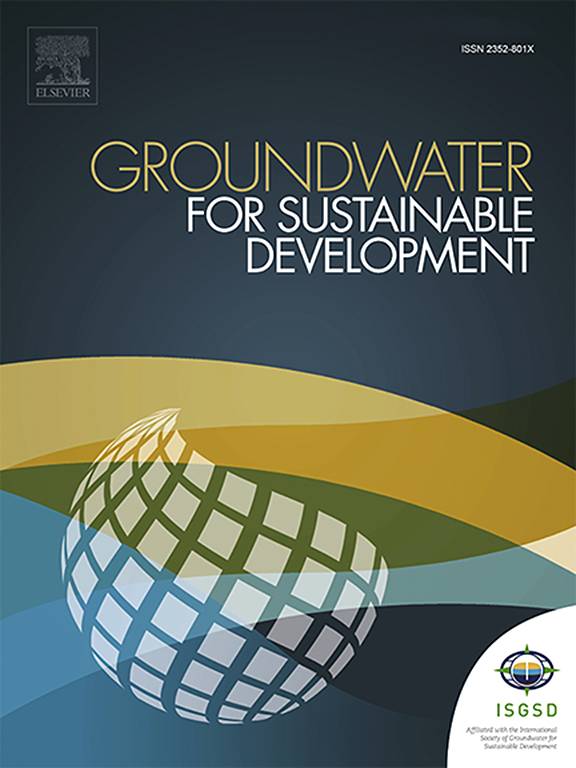利用同位素和地球化学示踪剂表征矿山废物堆的污染物运输:对津巴布韦马佐韦地区一个不活跃的黄铁矿的案例研究
IF 4.9
Q2 ENGINEERING, ENVIRONMENTAL
引用次数: 0
摘要
酸性矿井排水是历史黄铁矿附近地区一个全球性的、持续存在的环境问题。amd相关污染物向地表和地下环境的迁移是造成这一现象的关键因素。然而,由于对污染物的空间发生、分布和运输的了解有限,在一些不活跃的矿区进行AMD的补救工作经常受到影响。本研究利用同位素和地球化学相结合的方法分析了废弃矿山排土场周围的矿山废物、土壤、浅层地下水和地表水,目的是表征污染物向接收环境的迁移。相对于背景浓度,矿山排土场下坡土壤中Fe、As、Mn和Pb浓度升高存在空间差异。受amd影响的浅层地下水和地表水以SO4-Ca-Mg水为主,非amd影响的水以HCO3-Ca-Mg水为主。与地表水相邻的受特定amd影响的浅层地下水沿局部蒸发线(δ2H = 4.9δ18O - 6.4, R2 = 0.87)绘制出与δ18O和δ2H蒸发趋势一致的模式。浅层地下水δ18O含量相对丰富,SO42−浓度相应升高,而地表水则没有类似的变化规律。这些发现为从矿山废物到附近土壤、地表水和浅层地下水的污染过程和途径提供了精细的见解,可以支持该场址和其他类似场址的管理策略。本文章由计算机程序翻译,如有差异,请以英文原文为准。

Characterising contaminant transport from a mine waste dump using isotopic and geochemical tracers: A case study of an inactive pyrite mine, Mazowe district, Zimbabwe
Acid mine drainage (AMD) is a global and persistent environmental problem around areas in close proximity to historic pyrite mines. Migration of AMD-related contaminants into the surface and subsurface environment is a key factor contributing to this phenomenon. However, remediation of AMD at some inactive mining sites is frequently affected by limited knowledge on the spatial occurrence, distribution and transport of contaminants. This study utilised a combined isotopic and geochemical approach to analyse mine wastes, soil, shallow groundwater and surface water around an abandoned mine waste dump with the objective of characterising contaminant migration into the receiving environment. Elevated Fe, As, Mn and Pb concentrations spatially varied in mine wastes and soils located downslope from the mine waste dump relative to background concentrations. AMD-influenced shallow groundwater and surface water were predominately characterised by SO4-Ca-Mg water type whilst non-AMD influenced water was characterised by HCO3-Ca-Mg water type. Specific AMD-influenced shallow groundwater adjacent to surface waters revealed patterns consistent with an δ18O and δ2H evaporative trend by plotting along a local evaporation line (δ2H = 4.9δ18O – 6.4, R2 = 0.87). Relatively enriched δ18O composition of shallow groundwater had moderate corresponding elevated SO42− concentrations whilst surface waters did not show a similar pattern. The findings provide refined insights into contamination processes and pathways from mine wastes into nearby soil, surface water and shallow groundwater which could support management strategies at this site and other similar sites.
求助全文
通过发布文献求助,成功后即可免费获取论文全文。
去求助
来源期刊

Groundwater for Sustainable Development
Social Sciences-Geography, Planning and Development
CiteScore
11.50
自引率
10.20%
发文量
152
期刊介绍:
Groundwater for Sustainable Development is directed to different stakeholders and professionals, including government and non-governmental organizations, international funding agencies, universities, public water institutions, public health and other public/private sector professionals, and other relevant institutions. It is aimed at professionals, academics and students in the fields of disciplines such as: groundwater and its connection to surface hydrology and environment, soil sciences, engineering, ecology, microbiology, atmospheric sciences, analytical chemistry, hydro-engineering, water technology, environmental ethics, economics, public health, policy, as well as social sciences, legal disciplines, or any other area connected with water issues. The objectives of this journal are to facilitate: • The improvement of effective and sustainable management of water resources across the globe. • The improvement of human access to groundwater resources in adequate quantity and good quality. • The meeting of the increasing demand for drinking and irrigation water needed for food security to contribute to a social and economically sound human development. • The creation of a global inter- and multidisciplinary platform and forum to improve our understanding of groundwater resources and to advocate their effective and sustainable management and protection against contamination. • Interdisciplinary information exchange and to stimulate scientific research in the fields of groundwater related sciences and social and health sciences required to achieve the United Nations Millennium Development Goals for sustainable development.
 求助内容:
求助内容: 应助结果提醒方式:
应助结果提醒方式:


